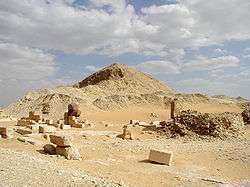Neith (wife of Pepi II)
Neith was an ancient Egyptian queen consort, one of the principal queens of the Old Kingdom pharaoh Pepi II Neferkare, who ruled (c. 2278 BC – c. 2184 BC). Queen Neith was named after goddess Neith.
| Neith in hieroglyphs | ||||
|---|---|---|---|---|
N.t Neith | ||||
Family
Neith is thought to have been a daughter of the pharaoh Pepi I and queen Ankhesenpepi I, making her aunt and cousin to pharaoh Pepi II.[1][2] Neith may be the mother of King Nemtyemsaf II.[3] There is a legend about Queen Nitocris who, if she indeed existed at all, may have been a daughter of Neith.[1]
Titles
Her titles as a royal daughter include: King’s Daughter (s3t-niswt), Eldest King’s Daughter of his body (s3t-niswt-smswt-n-kht.f), Eldest King’s Daughter of his body of Mennefer-Meryre (s3t-niswt-smswt-n-kht.f-mn-nfr-mry-r’), and Hereditary Princess (iryt-p`t),
As a wife of the pharaoh she used the titles: King’s Wife (hmt-nisw), Beloved King’s Wife of Men-ankh-Neferkare (hmt-nisw meryt.f-mn-‘nkh-nfr-k3-r’), Great of Praises (wrt-hzwt), Great one of the hetes-sceptre (wrt-hetes), She who sees Horus and Seth (m33t-hrw-stsh), Attendant of Horus (kht-hrw), Consort and beloved of the Two Ladies (sm3yt-mry-nbty), Companion of Horus (tist-hrw), and Companion of Horus (smrt-hrw)
Neith's title King’s Mother (mwt-niswt) shows that she was the mother of a pharaoh.[4]
Burial
Of the three small pyramid complexes built around that of the chief pyramid of Pepi II, Neith's is the largest.[1] Neith's pyramid may have been the first one constructed among the queen's pyramids associated with Pepi II. Neith's pyramid complex included a small temple, a satellite pyramid and a fleet of sixteen wooden boats buried between the main and satellite pyramid. The entrance to the enclosure was flanked by two inscribed obelisks. Neith's burial chamber and was inscribed with Pyramid Texts. This is the second known occurrence of these texts in a queen's pyramid, the first being those of Ankhenespepy II. The burial chamber contained a red granite sarcophagus (empty) and a canopic chest.[5]
The remains of at least part of her mummy were uncovered and were once housed in the Qasr el-Aini Medical School.[3]
Sources
- Tyldesley, Joyce. Chronicle of the Queens of Egypt. p.61 - 63. Thames & Hudson. 2006. ISBN 0-500-05145-3
- Verner, Miroslav. The Pyramids: The Mystery, Culture, and Science of Egypt's Great Monuments. Grove Press. 2001 (1997). ISBN 0-8021-3935-3, pg 359
- Aidan Dodson & Dyan Hilton, The Complete Royal Families of Ancient Egypt, (London: Thames & Hudson, 2004) ISBN 0-500-05128-3, p.77
- Grajetzki, Ancient Egyptian Queens: A Hieroglyphic Dictionary, Golden House Publications, London, 2005, ISBN 978-0-9547218-9-3, p.25
- M. Lehner, The Complete Pyramids, 1997, Thames and Hudson
